We occasionally link to goods offered by vendors to help the reader find relevant products. Some of these may be affiliate based, meaning we earn small commissions (at no additional cost to you) if items are purchased. Here is more about what we do.
This is the time of year when gardens and fruit trees are bursting with goodness. This is what we have been waiting for all year. Last winter it seemed as if eating fresh vegetables was just a dream, and now they are here!
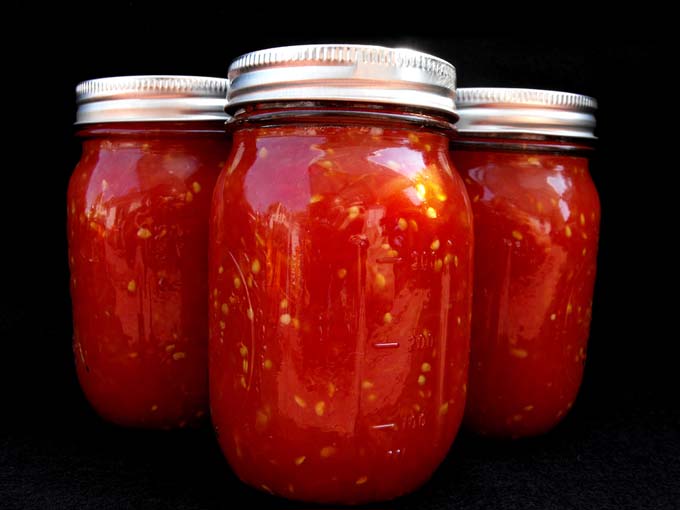
Eating Local, and Purple Beans
There has been a movement towards growing and buying local. If you know where your food comes from, you are often more likely to enjoy eating it. If you get the kids involved they develop an interest and will, most likely, eat what they have taken care of and watched grow.
Of course, this isn’t always true. My oldest daughter was about 4 when she decided she wanted to plant purple beans because purple is her favorite color. We planted them, watched them grow, oohed and aahed over them, and finally picked them.
I cooked them for supper that night and during cooking, they turned green. There was no way she was going to eat them. They were not purple anymore. A lesson learned from both sides.
Even steaming them would have taken away that vibrant purple color. Some vegetables are just like that. The anthocyanins that give them their color are apparently water soluble, and they’re also very susceptible to heat.
Tom-ay-to, Tom-ah-to
The top of my vegetable list is always tomatoes. A garden-grown fresh tomato cannot be beaten by anything we will find in the store. Living in Montana would be greater if we had the weather of California or Florida. We could have year-round gardens!
Tomatoes are one of the easiest vegetables to either freeze or can. They can be frozen whole. When they are needed simply thaw them out, remove the skins, and use in any recipe.
The best method of freezing involves taking individual tomatoes and placing them on a cookie sheet, frezing them solid, and then placing them in individual portions in freezer containers or freezer bags.
Canning is a bit more labor intensive and involves putting the whole tomatoes in boiling water for around 30 seconds to a minute, then removing them from the boiling water, and plunging them into an ice water bath.
This makes it easier to remove the skins. Then the tomatoes are sliced or diced into a big bowl. Let them sit while the jars are readied for canning.
Because many people in our part of the country are a self-reliant bunch, our stores always have canning supplies available, but it’s up to you as to what size jar you need. I usually use pint jars because they are easier to handle, and I can always use as many pints of tomatoes as is needed for a recipe.
Since tomatoes are high in acid, I normally use the water bath method of canning as opposed to using a pressure canner. As you are getting the jars and tomatoes ready to can, fill up the water bath canner with water, and put the rack in the bottom. Start the burner and bring the water to a boil.
Always remember to sterilize the jars and lids before filling with tomatoes. When canning tomatoes it’s easier to use a wide mouth canning funnel. These are great for putting the tomatoes into the jar, and they keep the rim of the jar clean.
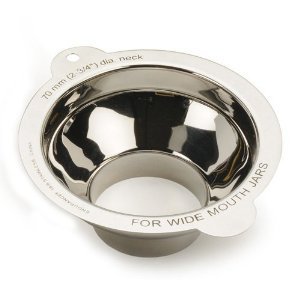
Foodal suggests the RSVP Endurance 18/8 Stainless Steel Wide Mouth Canning Funnel
When filling the jars, leave 1/2″ headspace at the top. I usually fill each jar to the bottom of the canning funnel. When all of the tomatoes are in the jar, put the sterilized lids on, then immerse them in the boiling water in the water bath canner. Pints are processed for 35 minutes and quarts for 45 minutes.
After processing, remove them from the canner and let cool on the counter. The fun part is listening to the lids pop as they seal. You can test for a seal by pressing down on the center of each lid.
If the lid gives, it means the tomatoes are not sealed. These can be put into the refrigerator and used as soon as possible – which (at our house) usually means that we have chili or spaghetti for supper!
The Pressure is On
Another way of sealing jars is to pressure can them. My husband is the king of pressure cooker users! When we were growing up, there were no microwave ovens, so a quick way of getting supper on the table was to use a pressure cooker.
My mother never used one because they freaked her out. She was always afraid that the thing would explode… and she passed that fear onto me (though many myths about their dangers have been debunked). However, my husband’s family always used their pressure cooker.
My mother-in-law worked outside the home, which for her time (she’s now 90 years old) was pretty amazing. So, at my husband’s home, getting supper on the table often meant using a pressure cooker to save time.
Now that we are grandparents and helping to raise grandchildren ourselves, the pressure cooker gets a lot of use. In fact, we have three pressure cookers of various sizes for different uses! We don’t currently pressure can, but that is always an option.
The recipe book that comes with the cooker is a good source for information as to how to pressure can. If you want more tips and tricks on how to get the best out of your pressure canner, we’ve got other article that have got them in spades!
Ring My Bell Pepper
Another veggie that I love is the green, red or yellow bell pepper. This would be the sweet variety. I’m not much for hot and spicy foods, but guess what… I’m married to a man that LOVES hot and spicy!
It has taken me 32 years to convince him that not everyone likes the same things he does, and could he please add his hotness and spiciness to his own plate, and leave the rest of us out of it?
When I receive peppers from a friend’s garden, the dinner of choice is usually stuffed peppers. YUM! If I ever have too many peppers, I can either freeze the stuffed peppers, or just dice up the extra peppers and freeze them on cookie sheets until they’re frozen, then put the peppers into freezer containers or bags. They are then ready for use in casseroles, soups, or stews.
I also make what I call “stuffed pepper casserole,” which is basically just the recipe for the pepper stuffing with diced peppers mixed in, and then I bake it.
Peachy Keen
At this time of year, there are usually a couple of local people who travel to the Washington/Oregon area with big trailer rigs, and they bring back peaches, pears, and apples.
Then, on their way back, they will stop in the Flathead Lake area of Montana and load up on some Flathead cherries. These people then sell their fruits to the locals, who are like rabid dogs when the truck arrives. FRESH fruit, wow!
We bought a box of peaches that needed to ripen for a few days. We just put the whole box into a large bag and let the methane gas (which fruit naturally manufactures) do the ripening. Then it was we have a box of peaches that we need to do something with right away!
We gave a few to my mother-in-law, gave a couple to a daughter, kept six out for us to eat, and froze the rest.
I love to eat a peach like an apple with the juice flowing down my chin (make sure you have a towel ready!) and of course everybody loves peach preserves.
Another favorite way of serving them is to dice up the peach into a cereal bowl, pour half and half or whole milk on it and some sugar, and dig in. If you like, you can use skim milk and sugar substitute, but what fun is that?
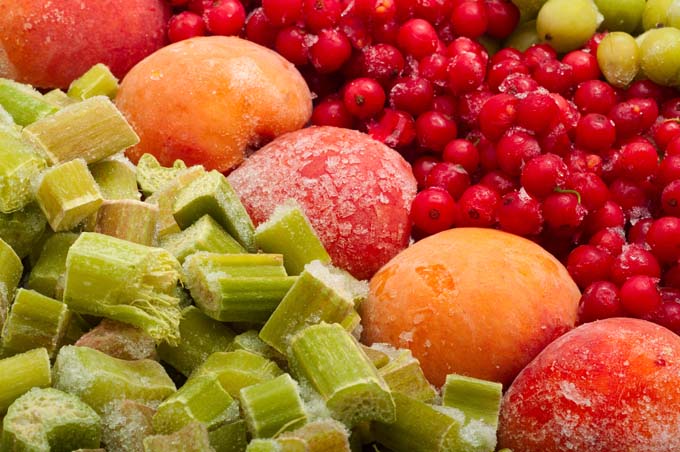
Preparing the peaches for the freezer is simple. Always wash the fruit and, using a small paring-type serrated knife, remove the skin. Cut the peach around the middle and use the knife to lightly separate the two pieces.
As you can see from the photo above, rhubarb freezes nicely, too. Check out this post for more info on preserving and enjoying this springtime treat.
Back to the peaches: Have a big bowl at the ready to slice them into. Remove the stem and the pit. Cut each half into six slices and drop them into the big bowl. Keep going in this fashion until all of the peaches are sliced.
At this point, squeeze a small amount of lemon juice on the peaches to keep them from browning, and sprinkle with sugar (to your taste). I freeze my peaches in two-cup plastic containers.
Remember: freezing causes expansion, so leave room in the container between the fruit and the lid. They are then ready for whatever you will need peaches for. Just thaw out and use.
An Apple a Day?
Whenever I receive a box of apples, my mind starts whirling as to what I should do. Of course, there are apples left out for eating. The rest is usually made into apple butter or apple sauce.
I don’t do pies, but I will part with apples if my mother wants to make a pie. I also love apple cake.
I have to relate a story about an attempt to make an apple cake when I wanted to substitute the sugar cup-for-cup with the sugar substitute aspartame. I had always been under the impression that this substitute can be used the same way that sugar can, however, I discovered that this is not so.
By the time I got done with the mixing of the cake, it looked like stuffing to be put into a turkey. It totally separated into little bread-like nuggets. I tried baking it… eeewwwww. That was a total flop! So now, if a recipe calls for sugar, I use sugar. I save the aspartame recipes for my cookbooks that will inform me how to use it.
Hope these tips for preserving and enjoying the season’s bounty have helped! Share some of your favorite produce freezing and preserving tips with me in the comments.

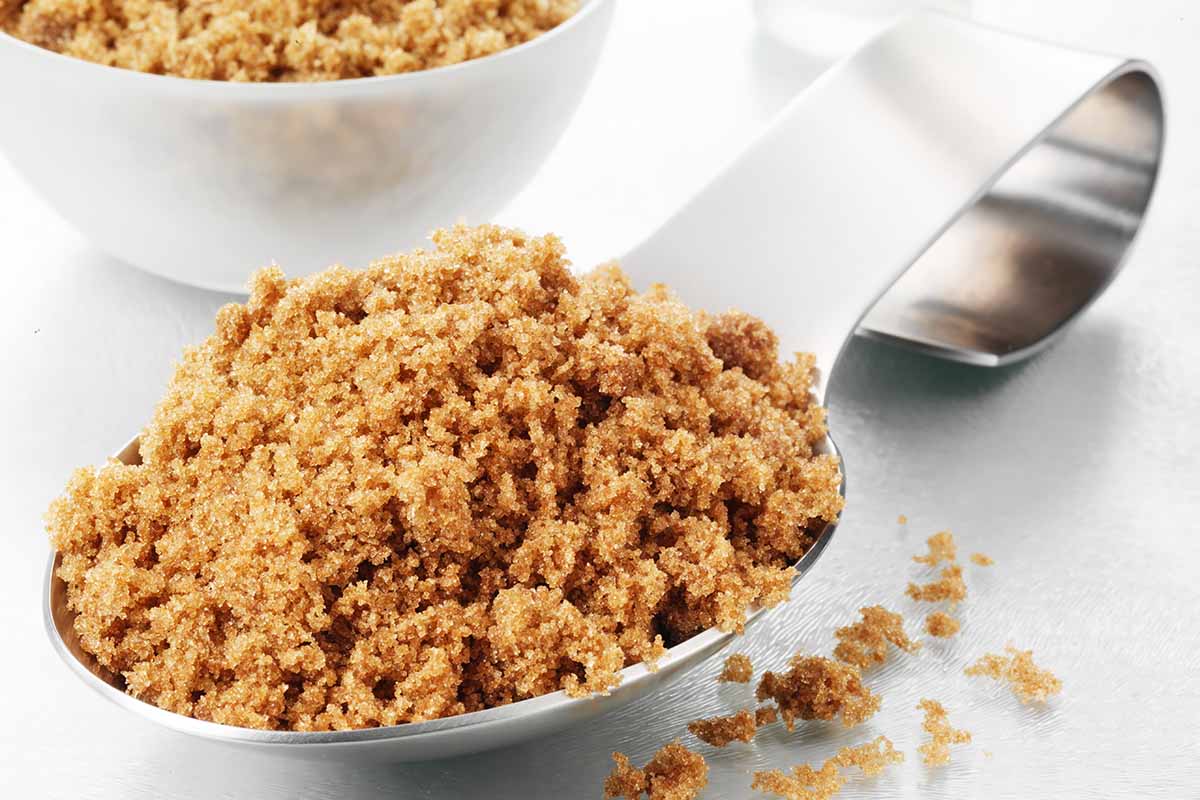
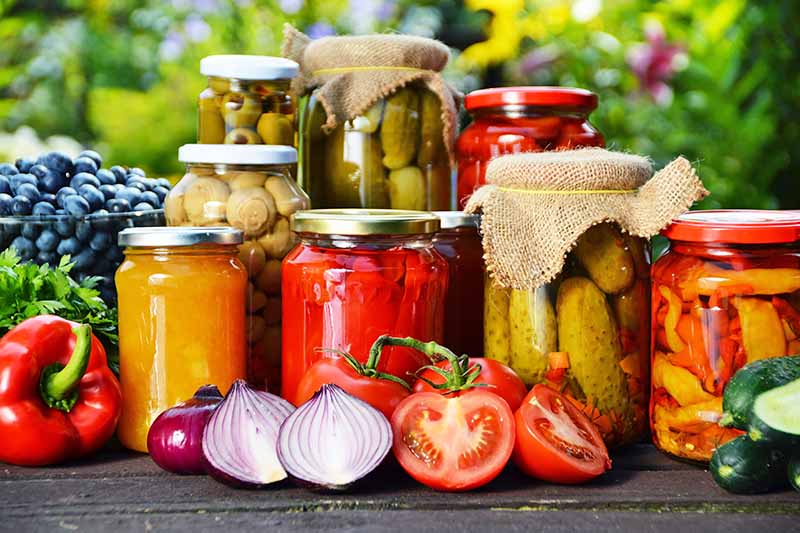
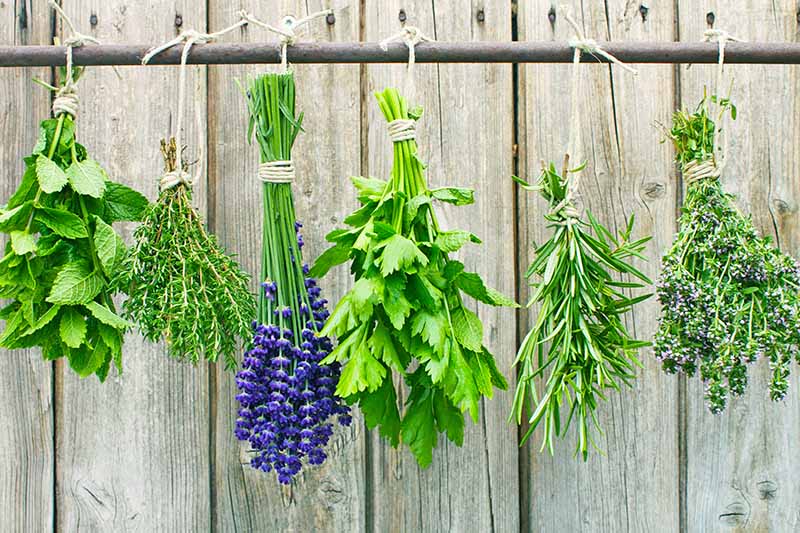
I am a huge fan of freezing fruits and vegetables as I believe that they taste fresher than canned veggies do. I also tend to believe that frozen veggies and fruits retain more of their nutrition than their canned brothers and sisters ever can.
Hi! I do freeze my veggies once in a while if I know I won’t be cooking it immediately… I agree it will retain its nutrition and it will extend its life when it’s frozen rather than just putting it on a refrigerator bin.
Both canning and freezing are practical ways just in case these fresh fruits and veggies are unavailable in the market. I guess, by doing both substitutes maintain and preserve the same content of nutrition and taste. So as long as they are helpful in our diets, I would consider doing both – canned and freezing.
I have a few aunts and friends that grow tomatoes. So every year, I get more than I can eat at one time. I hate throwing away fresh produce. So, I freeze them. It’s the easiest thing for me.
I rarely freeze them whole or sliced. They turn into missiles if you freeze them whole. I usually puree them first. and then I put the sauce in small containers, It makes it easier to retrieve later when they are frozen solid.
I like frozen more than canned — somehow, I just cannot figure out how to can proper, nor what to do with the canned fruits. They don’t inspire me. Frozen can go in smoothies and popsicles and cakes, so I tend to prefer that.
I have never done any canning. I do recall my grandmother and great Aunt canning tomatoes and also making homemade apple sauce from apples off the tree in the yard. I prefer freezing because it its easier and I believe it does retain more vitamins.
Very few people here in he UK can, so supplies are not readily available. I do freeze fresh fruits and veg though, I will portion up and freeze pureed tomatoes, boiled onions and berries. I was wondering if it is possible to freeze carrots and potatoes. I assume it is OK to freeze mash, but what about pre-cut fries, wedges etc?
I had never thought of freezing fruits, i always thought the law was canning them, never freezing them, i especially like that idea of freezing tomatoes, pretty neat, i must say, the freezing steps is what awes me much, considering how i have seen it done, which is packaging them in freezer bags and placing them in a freezer drawer in the refrigerator, now to see that they need to be wrapped individually in a cookie sheet, frozen solid then stored individually…well i must say that did raise my eyebrows in utter interest 😉
I definitely agree that we should freeze the fruits and vegetables that we buy. It can get rid of some of the germs that exist in our food and help us preserve groceries for a longer period of time. I’ve tried canning fruits and veggies before but i wasn’t really a fan of it. It felt time-consuming. With freezing, I can just puree it up and throw it in the freezer to defrost whenever I want. Meats are another favorite of mine to throw in the icebox. I often buy them in large packs and defrost when needed.
I prefer to freeze as it is easier for me as I portion things up. I do prepare them so when I do defrost I have done most of the work already. I like peppers, but hate deseeding them so often I will cook then in a batch then store them in jars with oil or make up a bag of chopped vegetables to freeze. As a single person, it’s much more convenient this way as I get a variety of vegetables that are quick to prepare.
I don’t have the room or equipment to start canning, but I do like the idea of preserving fruits and vegetables. I haven’t tried freezing yet, but that sounds like the way to go. I think I’ll be on the lookout for some good containers, then head to the local farmer’s market and try freezing some peaches, pears and other fruits.
I do wish that I had a place where I could grow tomatoes, but I don’t have a garden. I do like to dry tomatoes out and store them in olive oil when I have a lot. I never thought of canning them. I am certainly going to stock up in future and try out all I have learned here about preserving and storage of my foods.
Thank you for all of these great freezing and canning ideas! We do a lot of meal prep in this house, but one thing I have not ventured into yet is canning. It’s a fond memory I have of both my maternal and paternal grandmother’s while growing up. They both did SO much canning. As an adult, I now understand why they went through all that trouble! I often think about doing it, but scared I might screw something up in the process. Thank you for making me just a tad more confident to maybe try canning soon!
With freezing I worry about how much space I have in the freezer and if there is a power outage. With canning it’s time consuming and you have to buy jars. There’s good points and bad points to each.
Reading this article makes me feel lucky that I live in Florida. My family has a backyard garden where we grow eggplant, tomatoes, and calamansi (a citrus fruit). I had no idea that there was such a labor intensive process to preserving your food. When we want tomatoes, we can go to the backyard and pick some because they are there year-round. We don’t have to worry about them spoiling because we eat them the very same day that we pick them. If we want other fresh foods, we can head to a local farmer’s market and purchase it there year-round. Preserving foods via freezing or canning seems like such a hassle, and I feel blessed that I live in an area in which it is not necessary.
An interesting article on the preservation of vegetables and fruits, personally, I definitely prefer freezing them to canning them as the defrosted product always feels much fresher than the canned product, its also much more convenient as it takes up less time than canning which just makes it so much better. Overall, though, whether one chooses to can or freeze is their personal preference and both have their merits and their faults too.
There are certain vegetables and fruits I will freeze and others that I won’t. I do freeze kale and spinach but I find after I freeze them I can only really use them in smoothies or to throw in soup. They definitely don’t have the same taste but I can’t justify throwing them out when they are about to go bad.
I will also freeze orange slices, lemons and limes when they are about to go bad. It is so refreshing to throw them in a glass of water and while they definitely loose taste after being frozen I don’t see a huge difference. I will also freeze berries to keep them for the winter time. I have a blueberry bush and get so many during the fall. They are great to freeze and throw into smoothies or blueberry pancakes.
This is all very informative. I’ll keep it in mind the next time I want to can fruits or vegetables. I may also start doing so more often now that I am much more aware of some of the benefits.
I have a ton of tomatoes left over at the end of every summer. I find there is no way to really store them so I usually make a huge pot of sauce and freeze the sauce. I think some fruits and veggies are better stored this way than others. Unfortunately the two main veggies I grow tomatoes and cucumbers aren’t so I have to find other ways to preserve them.
I like to freeze extra foods since they retain more of their nutrients that way. Freezing just seems much easier than canning. All you need are containers of some sort and a freezer. I don’t care for the taste of canned vegetables either, but perhaps I would enjoy home canned veggies better than the store bought ones.
I usually puree my tomatoes before freezing and sometimes add basil and oregano. For some reason, I think the taste permeates the sauce better if the herbs are frozen with the tomatoes.
The big question is if anyone has seen any scientific data about the nutritional value comparing canning vs freezing. For me they both have drawbacks. Canning is a hassle and with extra stuff you have to buy, and a chance for a stinky failure. Freezing is fast and easy, but of course you might have limited space in your freezer.